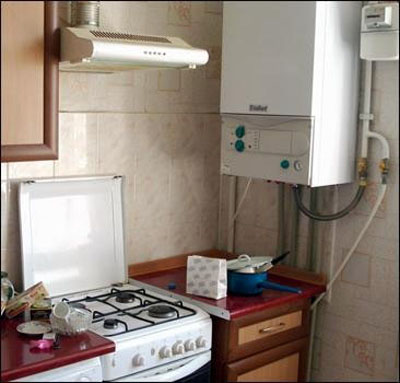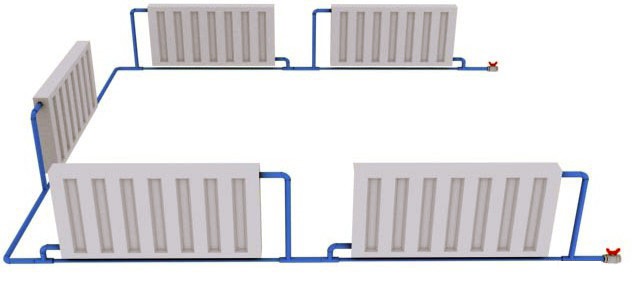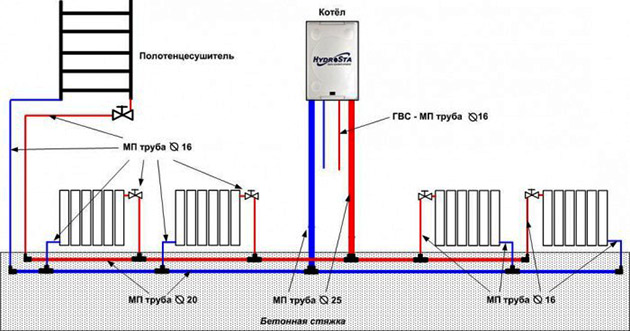Individual heating system in an apartment building. Types of individual heat supply. Features of individual heating
Due to the extremely low quality of heat supply services in apartment buildings, their owners show a great desire to make individual heating in the apartment. Tellingly, it is absolutely not difficult to implement this idea technically. But to refuse the services of a heat supply organization and obtain permission to install an individual heat source sometimes becomes an insoluble task. All the problems that arise in order and how to solve them will be described in our article.
Sequencing
So, it is very cold in your apartment in winter and you are tired of paying for a service that is not actually provided. Be sure to document this fact by submitting relevant applications to the supplier of thermal energy and to the sanitary and epidemiological station. Such fixation may subsequently play a role in the rejection and litigation, if it comes to it.
For reference. In the countries of the post-Soviet space, there are many legislative acts on this topic, often contradicting each other. Because of this, the question of whether it is possible to make individual heating in an apartment often has to be decided in court.
If you follow the right path, then the procedure should be as follows:
- carrying out activities to formalize the refusal of district heating services and the dismantling of old systems;
- obtaining permission to install an individual heat source in the relevant authorities;
- choice of energy source for heating the apartment;
- development technical documentation. In simple words, you need to complete a heating project with a diagram for connecting a heat source to centralized engineering networks;
- coordinating it with the energy supplier and obtaining permission to install a heat generator;
- installation work on the device heating system.
In practice, the greatest difficulty is the passage of the first 2 stages. The heat supply organization may prevent you from refusing services, referring to various legislative acts. The same story may repeat itself with obtaining a permit for the reconstruction of residential premises. You may have to enlist the support of a lawyer and even go to court. The subtleties of these issues should be studied on the relevant Internet resources.
For reference. In Ukraine, the installation of individual heating in apartment building prohibited by the relevant regulation, Russian Federation there is no direct ban, but there are a lot of restrictions in different normative documents causing discrepancies.

Choice of energy carrier
In high-rise residential buildings this choice is small, only natural gas and electricity are at your service. If you already had geyser, then it will be somewhat easier to change it to a boiler, although it is impossible to do without coordination with the gas supply office. Implement from scratch gas heating it will be more difficult, this is due to the registration procedure, chimney inspection certificates and so on.
Often natural gas as an energy carrier for an apartment has no alternative, since individual electric heating not available due to limited power consumption limit. Another reason not to settle for electric heaters is if you live in old houses with dilapidated wiring. Suppose you replace it within the apartment, and then? However, the electricity service company will not give permission under such circumstances.
If the listed restrictions do not exist, we choose the energy carrier for economic reasons. Much depends on the cost of gas and electricity in different countries. For example, the owner of an apartment with individual heating from electricity in the Russian Federation will pay more than for gas, in Ukraine - depending on the electricity tariff, and so on.
Installation of gas-using equipment will definitely cost more than electric.
Project development and installation work
It is at this stage that, together with the designer, it is determined what the individual heating system will be in the apartment and the boiler is selected according to its power. The latter is boldly taken at the rate of 100 W per 1 m2 of area, this is more than enough, since even corner apartment has many common walls with neighbors, and heat is not lost through these structures. The type of wiring can be selected depending on the size of the dwelling. For small apartments a single-pipe "Leningrad" is quite suitable, and for larger rooms - a traditional one two-pipe system with bottom wiring.
Please note that in the conditions of an apartment, only wall-mounted gas or electric boilers, and they already have built-in circulation pump, and sometimes expansion tank. So the system will be closed with forced circulation.
In addition to developing new scheme project documentation should contain a section that reflects the dismantling of the old system. Batteries and connections to them are subject to disassembly and disposal; risers passing through the apartment cannot be touched. Instead of a cut out bypass, a straight pipe section must be welded. To prevent the heat supply organization from continuing to charge you, the risers should be thermally insulated.
The new scheme for individual heating should provide for the installation of radiators with thermostatic valves at the inlet. The radiators themselves are suitable for aluminum, it makes no sense to install bimetallic ones. Concerning gas boiler, then its type depends on the presence of a chimney shaft. When it is, you can take a simple heater with open cam combustion.
Attention! It is forbidden to connect the boiler to exhaust ventilation shafts. If there is no chimney channel, then only a turbocharged heat generator with closed camera and coaxial pipe for exhaust gases through the wall.
By the way, for convenience, you can install a dual-circuit heat source, this will allow you to refuse from centralized hot water supply in the future. Also, if desired, an individual heating system with warm floors. Here it is necessary to pay attention to reliability. interfloor overlap. When there is no confidence in it, then it is not recommended to start a screed device, it is better to mount underfloor heating on wooden joists coated with laminate.
Since there are power outages in apartments, for reliable operation gas unit is better to have a block uninterruptible power supply. With electric heating, the situation is more complicated, it remains to be hoped that the shutdown will not last long. You can carry out the installation of individual heating on your own, except for one area: connecting the heat generator to the gas or electric networks of the building. For this service, you will have to contact the energy supplier.
Conclusion
As you can see, the new heating device in the apartment has its own characteristics. Most of the time and effort will be taken by the documentary-permissive part, and it is not a fact that you will receive this permission. In fact, do-it-yourself individual heating can significantly save money spent on central heating and hot water supply. Know that your efforts will not go to waste.
For providing temperature comfortable conditions answers in the apartment central heating. A large boiler house prepares a portion of the coolant and sends it along the highways to consumers. Several consumer houses may be involved in this chain.
However, not all residents agree with such an “imposition” of the service, because the heat supply starts and ends on the dates set according to the schedule from the average readings. Individual heating in the apartment will help to provide a personal approach to solving this issue.
Comparison with autonomous with central heating
The calculation of the cost of central heating is not based on the actual consumption of heat by users, but on the basis of established consumption coefficients. They are often overestimated in relation to the consumption, since the cost of tariffs includes expenses that are not available in apartments with individual heating:
- maintenance of main heating mains, carried out using heavy construction equipment and earthworks;
- obligatory losses of thermal energy upon delivery to the consumer;
- care shutoff valves with large diameters
- maintenance of the staff of boiler room maintenance personnel, etc.
The cost of operating individual heating in an apartment depends on the owner of the apartment, since he has the opportunity to independently increase / decrease the fuel supply.
The most popular is individual gas equipment, so it is often taken in comparison with the work of centralized boiler houses. In addition to positive properties, there are also objective factors that deter homeowners from starting to install individual heating in an apartment building. These include the following list:
- The price of high-end equipment pays off in a long time. This will increase the gas consumption.
- Monopolies in the right to provide permits for the installation of a gas boiler are gas distribution services.
- The boilers to be installed must have a burner closed type with an external street air intake. This approach increases the cost installation work. The use of house ventilation in many cases is unacceptable, since its channels do not meet the necessary criteria, in particular, in terms of diameter.
- The fire hazard increases due to the installation of an additional gas consumer, because even with careful operation, equipment explosions and other problems occur.
- Gas is non-renewable natural resources, so its value in the future will grow for consumers.
VIDEO: gas system do-it-yourself heating

The current federal legislation allows individual heating in an apartment building, this is spelled out in the law "On Heat Supply". The main thing is to answer necessary requirements provided in SNiP. Before you make individual heating in an apartment, you will need a certain set of documents:
- registration certificate of the premises (apartment);
- application for refurbishment management company;
- the project for which it is planned to carry out the installation;
- documents confirming the ownership of housing;
- written approval from all owners of apartments in an apartment building;
- if it is necessary to install autonomous heating in the apartment, permission is taken from the architectural authorities.
They can refuse only if the dismantling of the heating system in the apartment can lead to an irreversible disruption thermal equipment on the riser or in adjacent rooms.
What to do when you already have permission
After obtaining permission to install an autonomous heating system, you can proceed to the purchase of all equipment and conclude an installation contract.

All work on the installation of autonomous heating in an apartment building is carried out by specialists with a valid category of admission.
After installation and trial run, it is necessary to go through another round of approvals - with the same organizations where permission for re-equipment was previously obtained, including the fire service and the sanitary and epidemiological service. Only after that we can consider that the design is completed, and use the heating.
Carrying out power calculations
Before submitting documents for the refusal of the central heating and the connection of individual heating in the apartment, it is worth making a preliminary calculation. According to it, it will be possible to determine the required power of the future boiler.
For calculations, you will need to know the exact area of \u200b\u200bthe heated apartment. This takes into account climate zone in which the housing is located. The approximate value for the Moscow region will be in the range of 1.0-1.5 kW of power. For more northern regions, a heat generator will be required, with output values \u200b\u200bup to 2 kW. AT southern zone you can get by with a power of 0.7-1.0 kW.
Calculation of a boiler for heating an apartment in an apartment building:
|
Q cat \u003d S * W beats / 10 |
- Q cat - boiler power;
- S is the area of the apartment;
- W beats - specific power of the boiler per 10 m 2.
More accurate calculations individual gas heating in an apartment building should include a pipe layout: two-pipe or one-pipe wiring. The first option is more difficult, but more effective for large rooms. The second option is simple and less material, but its result is preferable for small areas.
Boiler selection

Since, in order to make individual heating in an apartment building, you need to buy a boiler, it is advisable to choose it according to performance characteristics. The main difference between them is the presence of one or two circuits.
- single-circuit boilers are engaged in heating only the coolant in heating.
- double-circuit boilers provide heating of the heat carrier and water in the DHW system.
According to the type of fuel consumption, autonomous heating of an apartment in an apartment building can be as follows:
- exclusively gas;
- exclusively electric;
- combined gas and electric.
The material for the boiler can serve:
- steel;
- cast iron;
- bimetallic alloys.
The most durable are cast iron products, but they are heavy and are found in older models of equipment.
Pipe selection
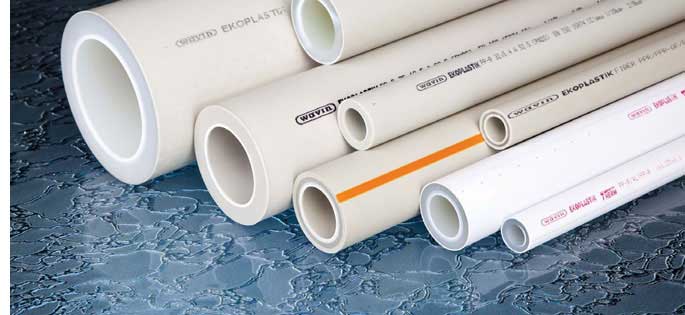
Lines for wiring are selected based on the temperature of the coolant, as well as the convenience of working with them. In the vast majority of cases, polypropylene is the actual material for installing individual heating pipes in an apartment building. However, it has its drawbacks.
Maximum allowable temperature coolant in polypropylene pipes is 95 0 С.
If a hotter coolant is expected, then it is necessary to mount the wiring from metal pipes.
Selection of sectional radiators

Since you need to make individual heating in an apartment building with a high degree of return, you will need high-quality multi-section radiators. The heat transfer coefficient of each of them directly depends on their basis:
- cast iron - 100-110 W;
- steel - 80-85 W;
- aluminum 170-190 W;
- bimetallic about 200 watts.
To pick them up right amount for a room, you need to use the following ratio:
Accordingly, to heat a room of 10 m 2, you need 10 cast iron sections or 5 bimetallic sections.
System installation
Pipe routing can be carried out in such a way that they are eventually hidden under the coating or they will be located around the perimeter of the room. The installation of radiators is carried out at a later stage.
To connect the boiler to the mains, it is advisable to call specialists. You will also need help from staff. gas organization for connecting the boiler to the gas network.
Without the participation of certified specialists from the gas organization, work on connecting the boiler is prohibited.
The system must be checked for tightness after the coolant has been put into it. If leaks are detected, it is necessary to solder the leaks or replace the problematic section of the pipe.
VIDEO: How to save on heating in an apartment building
Approved by an expert
Poor-quality heat supply in apartment buildings is pushing many of their residents to switch to individual heating. The demand for this system is due to the ability to independently regulate the temperature in the house and not depend on various external factors. Thanks to the presence of individual heating, at any time of the year, the room will be as warm as you want. But warm house even in severe frosts - it is always comfort and coziness.
In addition, you can save a lot. After all, you do not need to use additional heaters in cool weather and consume electricity. It will only be necessary to turn on individual heating, setting the temperature that will make you feel comfortable.
Attention: systems based on double-circuit boilers allow not only to heat the room, but also to provide hot water. This versatility further increases the demand for individual heating. After all, thanks to him, you can enjoy not only heat, but also hot water.
As practice shows, individual heating in an apartment building is more profitable than centralized heating. Its advantages are as follows:
- Possibility to regulate the temperature. To do this, you only need to set the desired parameters. If necessary, they can be reduced or increased.
- Saving. It allows you to save a lot. After all, if necessary, the temperature in the rooms can be reduced independently. This means that the amount of fuel burned will decrease. Accordingly, the costs will be less.
- Possibility to set the desired temperature. To different people required different temperature in the apartment to feel comfortable. This can be achieved only with the help of individual heating.
This system also has some drawbacks - the difficulty of obtaining permits and the high cost of its purchase and installation. But the latter will quickly pay off.
When installing individual heating for an apartment, it should be borne in mind that it is somewhat different from a similar system for heating a private house.
Heating of a private house
Before moving on to individual heating for apartments, you should briefly consider the system responsible for heating and hot water supply. individual home. After all, not every boiler that is suitable for a private house can be installed in an apartment.
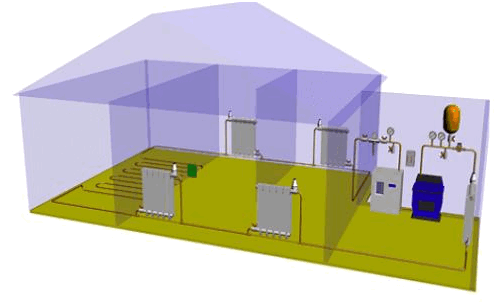
The scheme of individual heating of a private house is also significantly different, since in the first version single- and double-circuit boilers can be used.
Attention: Single-circuit boilers used only for heating. To heat water in them, you should additionally install a boiler. If for houses this option is acceptable, then for apartments, no, since the boiler will take up free space, and this is not rational. Therefore, it is recommended to install double-circuit boilers in apartments.
Disconnection from central heating
Before installing the individual heating system, disconnect from the existing heat source. A lot depends on where your apartment is located.
If the high-rise building is new, then it will not take much time and effort. Moreover, modern apartment buildings with individual heating installed by developers is now not uncommon. After all, one of the main goals modern construction, is the efficient use of energy resources.
But if the house in which your apartment is located does not belong to this category, then you should not be upset. After all, to turn off central heating in modern home, just turn off the desired valve and you will no longer receive heat. Such ease of shutdown is associated with the presence of individual wiring of heat carriers. In addition, each apartment has its own counter.
It will be more difficult to disconnect from district heating in homes old building, because the heat supply is common there, and passes through the riser from one apartment to another. If you live on the middle floors of a high-rise building, then dismantling heating devices will be problematic. But if you live on the edges of the risers, for example, on the top floor, then this is much easier, although it will take some time.
Having coped with the shutdown of central heating, you will need to issue Required documents about putting the apartment into operation, but with a new heating system, after which, hand over the papers to the right organization.
Boiler for an apartment
Before installing individual heating, you should decide in advance which source of heat you will use. Many people prefer electricity. But the ideal option for apartments with gas supply is gas.

Much depends on the choice of boiler. You should immediately abandon the idea, install a boiler for liquid or solid fuel. They are suitable for heating a private house, but not an apartment. After all, such equipment will require a separate room. You can not do without a supply of firewood, pellets, diesel fuel or coal. And they are simply not allowed to be stored.
Attention: ideal option for the apartment there will be an installation of individual heating based on a double-circuit gas boiler. The demand for them is quite high. Installation is quite simple and does not take much time.
Read the material about the advantages and disadvantages.
Advantages of the boiler
For the operation of a double-circuit gas boiler, air taken from the street is used, and all combustion products are removed using ventilation pipes. Their level of automation is quite high and you will only need to set the necessary parameters for it to work.
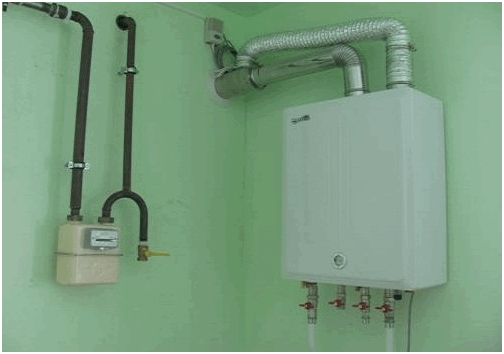
Thanks to a well-thought-out automation system, gas is supplied and ignited in the burners after receiving a positive signal from the existing sensors. This cannot happen spontaneously.
The coolant in the system circulates due to the presence of a pump. Can be used as a coolant plain water, or special antifreeze.
In what room should it be installed
Attention: Gas boilers in apartments can not be installed in all rooms. The room in which it will be located must meet the following requirements:
- Area not less than 4 square meters, have an entrance door, the width of which is more than 80 centimeters and a window.
- Depending on the model, it may be required to have in the room compulsory system ventilation.
- The wall on which the boiler will be mounted must be made of non-combustible material. If there is no such wall, a covering of fire-resistant material should be placed between the wall and the boiler.
- If there are other heating or gas appliances, the distance to them should be at least 30 centimeters.
All of the above requirements are mandatory. They must be observed in full to prevent negative consequences.
Boiler installation
Before installing the boiler, you should obtain all permits for its use. The commissioning of the tank must be carried out in the presence of representatives of the organization responsible for the use of such equipment. They are also involved in the preparation of projects for their installation. Even if the project was drawn up independently, it must be approved by a similar organization.
Due to its compactness and low weight, a gas double-circuit heating boiler is most often mounted on a main wall. If necessary, a partition wall is also suitable for this purpose. But it must be well fortified.

Having chosen the place where the boiler will be located, it should be fixed on the wall mounting strips. After that, you can hang the boiler itself.
Attention: When fixing it, it should be noted that the lower part of the boiler must be located from the floor, at a distance of at least 1.6 m. Detailed scheme installation must be included in the user manual.
The boiler must be connected to the gas pipeline with metal pipes that have the necessary certificates or with special rubber hoses. Connection points, without fail, should be carefully checked for tightness. For this purpose, you can use a solution of soap. After the installation of the tank, the heating circuit must be connected to the existing heating system.
Conclusion
Individual heating- it is an opportunity to enjoy the warmth, not depending on external factors. The temperature can be easily adjusted by yourself. By installing a wall-mounted double-circuit gas boiler in the apartment, you can provide not only good heating in the house, but always have available hot water. Of course, the installation of such a system will require a significant investment of time and money, but all this will quickly pay off.
The cost of centralized heating services is not always justified. For this reason, owners often decide to switch to individual or apartment heating.
What is the difference between these procedures and what does the law say about it?
The main reason why most homeowners in an apartment building want to switch to individual heating is the discrepancy between the cost of services and their quality. Of course, each case is unique.
For example, heating season, on average, begins in mid-October and ends in March-April. But, if in March the walls of the house have time to warm up and the cooling is not felt so clearly, then in October it is quite difficult to wait for heating.
The heat carrier is supplied to the CHP plant at a fixed temperature, essentially independent of whether the heat carrier is supplied through a distributor or not. This temperature is also not always enough, although, in fact, the company believes that the heating season is open.
It is also worth noting the state of heating systems. AT high-rise building of the old type, these systems have long been worn out, and salt deposits and rust do not allow maintaining the optimal supply pressure of the coolant, and, as a result, the necessary heat transfer at the outlet.
It turns out that, according to the company, heating is supplied and the service is provided, payment for it is charged in full, but the client, at the exit, receives a completely different level of heating for which he pays.
The company should not be blamed for this. Natural gas for CHP is supplied at a higher cost than private individuals. In addition, repairs of heating systems and heating mains are required annually.
Boilers are also subject to wear and tear and require repair, especially considering that most of the CHPs were built back in Soviet times. In addition, heat losses on heating mains, where unscrupulous citizens tore off thermal insulation, also affect the level of service quality.
Open entrance to minus temperature, a leak in the radiator, a breakdown of the valve of the elevator assembly and many more nuances that are not visible on the surface, significantly affect the cost and quality of heating.
Individual heating

The law has nothing against you connecting individual heating. But first it is necessary to solve a number of technical and legal problems that stand in the way.
The main problem of tenants who would like to install autonomous boilers, hiding in the arrangement of houses. The central system is a kind of network with common risers, fittings, pipelines and meters. Disabling one cell can lead to the failure of the entire system, and therefore requires its cardinal change. This is from a technical point of view.
From a legal point of view, the heating system in an apartment building is common property, which means that all residents have the right to dispose of it in equal shares. And therefore, the issue of disconnection is decided at a general meeting in an apartment building.
Disconnecting one apartment from the system will reduce the amount of common house property, therefore the issue cannot be resolved only unilaterally. Self-shutdown is not logical, it must be carried out by specialists who will be guided by the appropriate decision.
When is the consent of the neighbors not required?
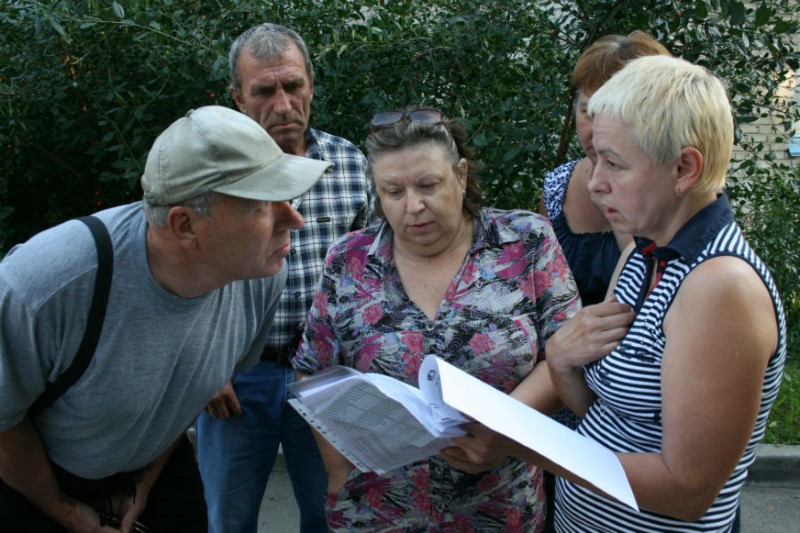
It also happens that the issue can be resolved without a general house meeting. This happens when the heating system in the house and all its elements are not designated by the documentation as common property. But even this fact does not imply that self shutdown will be legitimate.
In this case, it is necessary to obtain permission from the local organization that provides resource supply services, since the conversion will require changes to the house registration certificate.
In its third section, in particular, detailed information about the heating system is listed. Any change and installation is regarded by the law as a technical change, which must be made to the technical passport.
The procedure goes better if all the residents of the house want to connect individual heating.
Required documents

The law states that absolutely any homeowner has the right to individual heating and disconnection from the central heating.
To complete the procedure, the owner must provide:
- the conclusion of the engineering company on the technical feasibility of re-equipment;
- written consent of all tenants of the apartment;
- documents certifying the right to own an apartment;
- technical passport of housing;
- free-form application.
The law also requires the submission of a draft as one of the main documents in the package. The project is being developed by water and heat supply engineers.
It is also worth entrusting the project to specialists because independent re-equipment, sooner or later, will be fixed and dismantled with a return to the central heating center, it’s good if this happens before the neighbors are flooded from below due to improper wiring, installation or pipe cutting.
The project is compiled exclusively by specialists who calculate the changes. The calculation determines what impact a future shutdown will have on the operation of the heating system in the house. In addition, specialists carry out thermal-hydraulic calculation and calculation of heat transfer from the riser.
If the calculations show that there is a technical possibility to re-equip the heating, the project can be coordinated. If it turns out that the shutdown will worsen the heating result in the remaining apartments, most likely, the project will not be approved.
Possible obstacles
Getting permission for individual heating, as it seems at first, is not difficult, but in practice there are a number of difficulties. The Law "On Heat Supply" (FZ-190) prohibits the transition to individual heating, although it does not prohibit the owner from installing individual heating boilers.
Moreover, the document provides complete list specifications required for regular installation.
At the time of obtaining permits, the type of equipment must be taken into account in the project, and if the project technically permits this device, then the authorities usually do not refuse to install.
The technical side of the issue

When permits are obtained, they proceed to technical re-equipment. The law allows only specialists to entrust the dismantling of the old system. The algorithm of work is almost the same as installing boilers for private houses, but a few subtleties should be remembered.
Autonomous heating in the apartment is often carried out by mini-boilers. The boiler is installed above the radiator, so the unauthorized circulation of water in the heating system is disturbed, and it is specially adjusted using a circulation pump.
Some boilers are immediately equipped with pumping elements, as well as a safety group and expansion tank. This type is more advantageous than a separate pump.
The law also determines the type of boiler that will be used in autonomous heating. Its combustion chamber must be closed, it must be equipped automatic system outages, working temperature water should not exceed 95 degrees, and operating pressure systems - 1 MPa.
The radiator, as practice shows, it is better to use aluminum, as it has good heat dissipation. But you can spend a little more, and pay attention to bimetal radiators, which serve much longer and are not afraid of water hammer.
The wiring is most often performed with plastic pipes.
Apartment heating
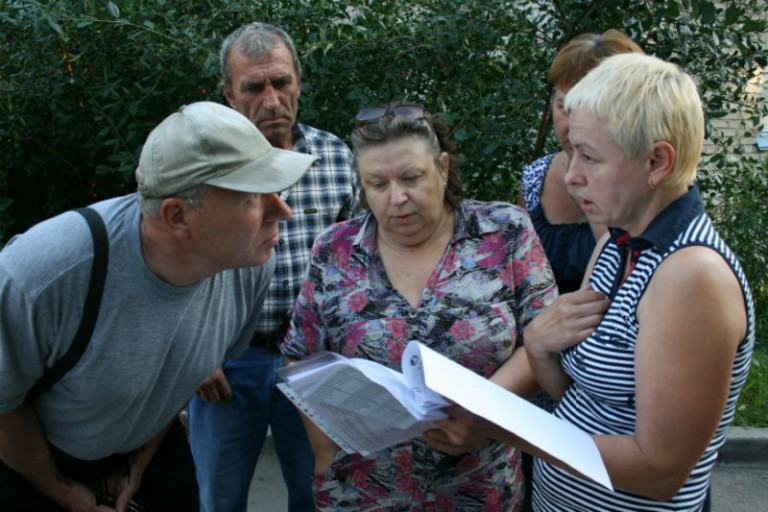
In the first case, there is centralized heating, from which the owner intends to abandon and switch to individual. In this case, we are not initially talking about centralized heating.
This often happens in new buildings, when the house is not connected to the central system, and each apartment has a gas double-circuit boiler.
Apartment heating is beneficial for both the developer and the buyer.
The first saves money on risers and wiring, as well as time for additional documentation. The second receives housing with a choice of heating level and time when it is needed.
But there are also cases when the boiler is not pre-installed, and the commissioning of houses is carried out without solving the heating issue.
When there is no boiler
The law does not prohibit residents of such houses from installing apartment heating in accordance with the requirements fire safety and at your discretion. But a number of problems still occur along the way.
A solid fuel boiler is immediately unacceptable. Firstly, there is no place for coal and firewood in the apartment. Secondly, the maintenance of such a boiler is frequent and expensive.
Solar burners are also unacceptable, as high level noise and capacity, at least a few cubes, are not suitable for use in an apartment.
Direct heating with electricity, including the use of infrared emitters, underfloor heating and climate systems, can be quite expensive compared to gas. A good alternative is an air-to-air heat pump.
If the façade of the house is insulated, the costs, by means of a pump or electricity, are significantly reduced. In addition, heating is provided when you want, and not when it is required throughout the house.
If the boiler is

Apartment heating of new houses is often organized on the basis of gas boilers. In fact, gas heating, on this moment, is the most profitable, in comparison with all other types.
If we consider why developers refuse central heating and why it is beneficial for you, you can find obvious reasons.
Firstly, the high cost of DH services is quite justified. High tax for gas for CHPPs, depreciation of equipment, repair and replacement of heating mains, heat losses - all this is paid, to one degree or another, by the subscriber of the company.
If a boiler is installed in the apartment, there are no such problems, and the cost of heating, with the same power, will cost at least two times cheaper.
But there are also a few drawbacks. The removal of combustion products is carried out by coaxial air ducts to the facade (unless the design of the house was originally optimized for apartment heating).
Otherwise, it is better for residents of such houses not to open windows again during the heating season. If the design of the house is thought out in advance for this type of heating, then air intakes are displayed on the facade, removing waste in such a way that all the boilers of the house can simultaneously operate at full capacity in the complete safety of residents.
Corner and middle apartments will consume different amounts of gas, respectively. And if central heating for such houses solves the problem with the same cost of payment, then the payment will depend only on the individual boiler output.
And finally, the insecurity of gas, even though modern boilers are equipped with last word technical security. The risk that one of the residents will not cope with the equipment still remains.
Conclusion
Disconnect from central system heating is possible only when the project proposed by specialists is approved, and the equipment selected for heating meets all the requirements that the law puts forward.
Arbitrarily performing such work is not only illegal, but also unsafe for your own, first of all, property.
At houses with apartment heating the situation is simpler: the owners can always open the heating season when needed, heating the apartment as much as needed.
But, sometimes, even a technically well-thought-out apartment (for individual heating) does not have equipment upon purchase. Then you have to choose from alternative options, such as climate systems or air pumps.
Many homeowners in apartment buildings are not too happy with the heating service. It is either there or not, and the temperature of the batteries may not depend on the temperature on the street. But you want the apartment to be warm in severe frosts, and on a fine May day, the batteries are not fried, as in a severe cold. In addition, heat generating companies and management organizations do not get tired of pleasing their customers with not too humane price tags for heat. Of course, you can cut this Gordian knot and just build yourself a suburban doi, where everything will depend only on you. But, with a certain skill, it is possible to achieve individual heating in an apartment building.
Two sides of the coin
Let's make a reservation that the creation of a completely autonomous, individual heating scheme for housing in an apartment building has two sides of the issue: legal and technical. Oddly enough, but the technical side of the issue is much easier to solve - modern manufacturers offer the widest selection individual heating systems: from the simplest fan heaters to advanced complexes powered by renewable energy sources. But with the legal registration of leaving for "free heating swimming" you will have to tinker pretty much.
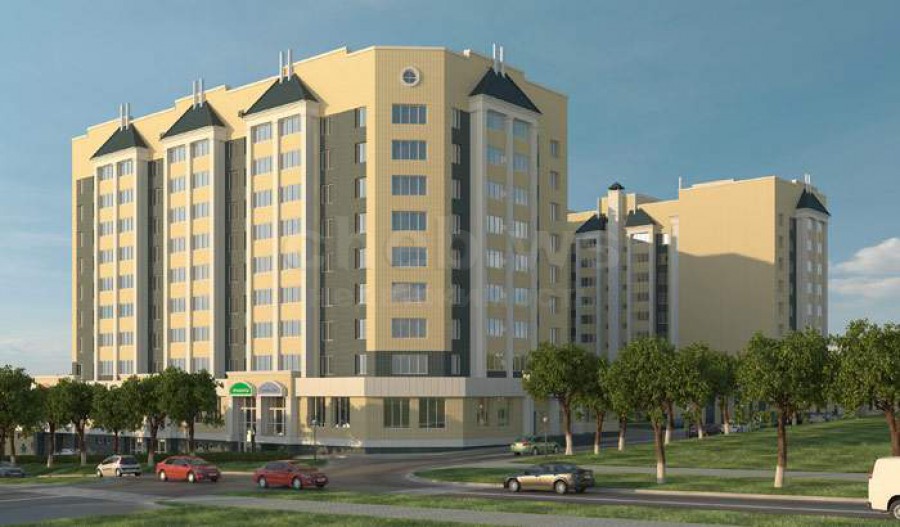
We will consider the most cardinal option - a complete shutdown from trunk systems heating. Indeed, why pay at the same time for the thermal services of the management company and spend money on maintaining your own individual system heating in the apartment.
We disconnect from the main heat
First of all, you will have to get rid of all heat sources in your apartment, in which the coolant supplied by the management company passes.
In new buildings, this can be done very simply - in such houses, as a rule, individual distribution of the coolant to each apartment is practiced, while each apartment has individual counter. Accordingly, it will be enough for you to simply turn off the valve and the heat bill for your apartment will be frozen.
But with houses of old construction, the situation is much more complicated. The fact is that there is simply no individual heat supply in such houses. Heat supply pipes pass from one apartment to another along the riser. As a result, remove heating appliances in apartments located on the middle floors of apartment buildings, most likely it will not work.
But in apartments that are located on the edges of the risers, that is, on upper floors it is quite possible to remove the heating devices completely. Such a precedent already exists - a resident of Izhevsk thus converted ordinary apartment, located on the extreme, fifth floor of the usual typical "Khrushchev". He drew up a refurbishment project in a specialized organization, hired a team from a company licensed to carry out construction and installation work in the field of heat supply.
When refurbishing an apartment, it is necessary to pay attention to the fact that the pipelines of the main heating systems do not give off heat to your apartment. Our hero closed the circuit in the floor screed of his apartment, using for this metal-plastic pipes with minimal heat transfer. Thus, the lower floors were not left without main heat, and no one could reproach him for being heated by these pipes.
After the repair work it is necessary to obtain documents on putting the apartment into operation, which indicates the new heating characteristics. How such paper should look like is shown in the figure. After that, such paper goes to the management company and you have to endure another round of the battle with the employees of the management company, who obviously will not want to reduce their income due to the fact that you will no longer pay for heat.

We install an individual heating system
Along with the epic of disconnecting from the main heating, in parallel, you must also consider the parameters of your own individual heating system. By by and large the choice of its type depends on what type of energy is supplied to your apartment. In the absence of main gas supply, the natural choice would be to create a heating system based on electricity. A very popular solution in this area is the installation of underfloor heating. They can be placed over the entire floor surface of your apartment and can have individual adjustment devices. Adjusting the level of heat given out by warm infrared floors can also occur automatically, depending on the ambient temperature in the apartment.
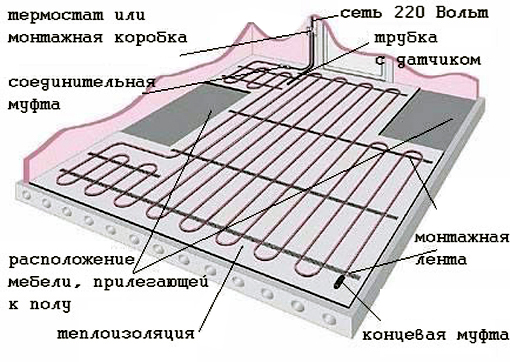
Installation of warm electric floors is quite simple and accessible to people with minimal technological skills. The only important issue that will need to be addressed with this approach is the restructuring of the electrical wiring system in the apartment. In older homes, aluminum wiring may simply not be able to withstand the combined power of electric floors. So you will most likely have to change the aluminum wiring to copper, laying an individual cable to each room and leading them to the apartment's switchboard with a separate circuit breaker connected.
Installing solid or liquid fuel boilers in apartment buildings is not practical. Under such equipment, as a rule, allocation is required a separate room, and hardly anyone will allow you to store a supply of coal, firewood, pellets or diesel fuel in an apartment building. Yes, and this approach is simply inconvenient.
The natural choice when creating an individual heating system in the presence of main gas supply will be the design and installation of a structure based on a gas boiler. This is a popular design, especially since in many of these apartments hot water is provided just by heating water in a gas boiler.
We purchase a double-circuit gas boiler
The key element of your individual heating system based on the main gas supply will be a double-circuit gas heating boiler. The installation of this system is quite simple and does not require, for example, the construction of a gas-tight gas duct.
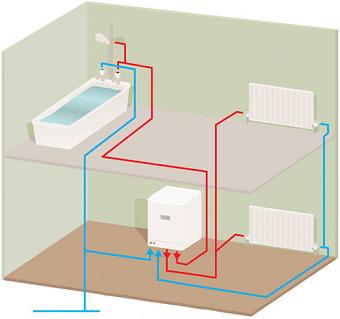
This modification of the gas boiler takes oxygen directly from the atmospheric outdoor air. The products of combustion are removed by means of a system of ventilation pipes.
A schematic diagram of a double-circuit gas boiler is shown in the figure.
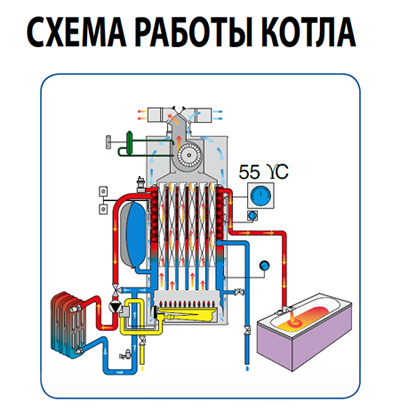
Such devices have a high level of automation, which will give you the opportunity not to be present during the entire cycle of the device. It is quite compact and has excellent functional characteristics. This equipment is reliable and faithfully will serve you for many years.
The automation of such a boiler supplies gas to the burner and ignites it only after receiving a positive response from all sensors that control many parameters, for example, from the level of coolant in the system.
The circulation of the coolant in systems based on double-circuit gas boilers is carried out by means of a pump. Water or a special antifreeze can be used as a coolant.
We allocate a room for a gas boiler
However, gas boilers may not be installed in all areas of your apartment. The room in which it will be located must meet the following safety requirements:
- Its area cannot be less than 4 square meters. The room must have Entrance door at least 80 cm wide.
- In addition to the door in such a room, there should be a window overlooking outer wall building.
- Some modifications of heating boilers require the presence of forced ventilation in the room.
- The boiler itself must be fixed to a wall constructed of non-combustible material. If such a wall is not found, then between the wall and the boiler it is necessary to place a reliable layer of material that prevents the spread of fire.
- The gas boiler must be located no closer than 30 centimeters from other gas or heating appliances.
These requirements must be carefully studied, as failure to comply with them can lead to very negative consequences.
How to install a wall-mounted gas boiler
The "heart" of your individual heating system will be a wall-mounted gas heating boiler. General circuit diagram installation of wall-mounted gas boilers is shown in the drawing.
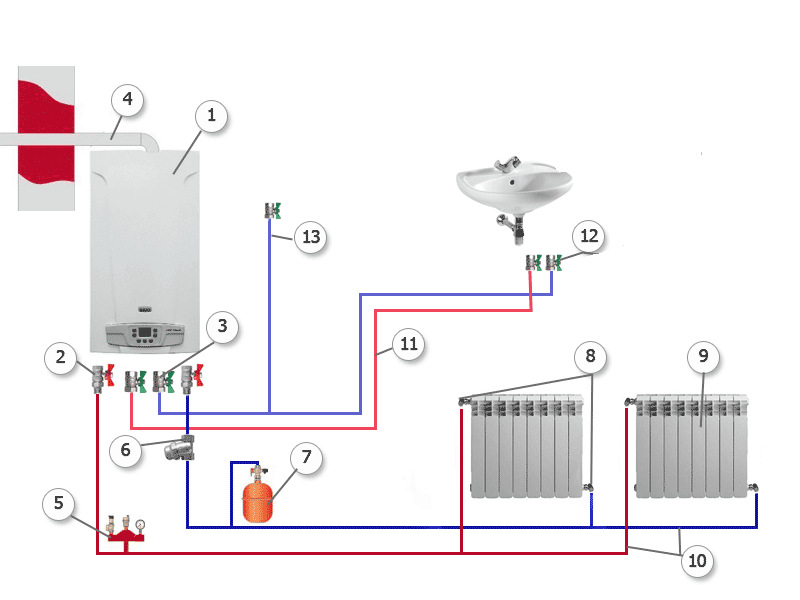
This design is very compact in size, light in weight, reliable and efficient, and therefore won wide popularity among consumers.
The place for the installation of such equipment is to choose the main wall of the room. In extreme cases, the boiler can be placed on a sufficiently reinforced non-capital partition.
Mounting strips must be fixed to the wall according to the selected mounting location. The lower part of the gas wall-mounted boiler should be located in the range of 1-1.6 meters from the lower level. The layout of the mounting elements is usually available in the operating instructions for your equipment.
Please note that gas equipment is a source of increased danger, therefore, its commissioning is carried out only in the presence and after obtaining permission from a specialized organization that has the appropriate licenses. Such organizations also carry out the design of the installation gas equipment. In any case, even with the independent development of such a project, it must be approved by an authorized organization.
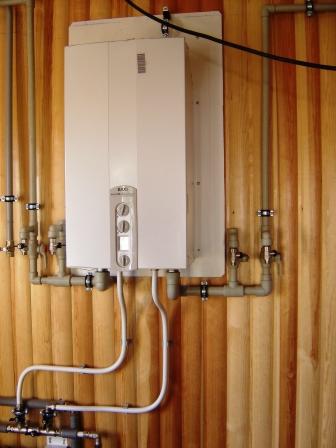
The connection of gas boilers to the gas main is usually carried out by means of metal pipes that have a certificate for use in gas supply systems. Alternative option gas connections may be special rubber hoses. Each junction of gas pipelines must be checked for leaks. For this, the usual soap solution which will show you where the leaks are.
After installing the gas wall-mounted heating boiler, the heating medium heating circuit is connected to existing system heating, disconnected from the main heat supply. Pumps are used to ensure constant circulation of the coolant in the system. There are modifications of gas boilers, which include, in addition to the heat exchanger, a pump unit that ensures the movement of the coolant to the heating radiators.
Individual heating in an apartment building: video
